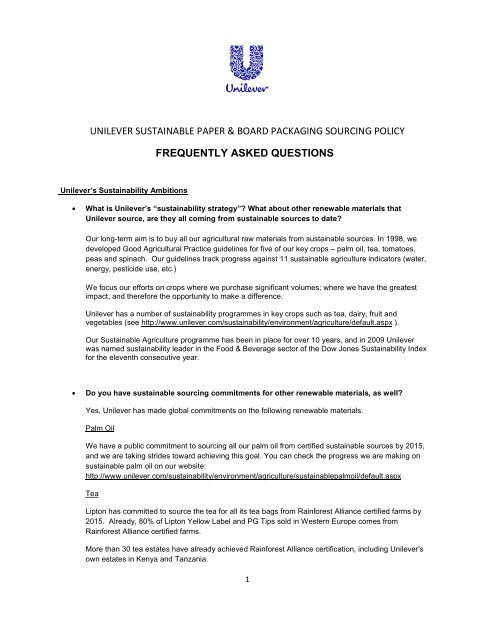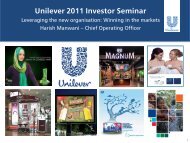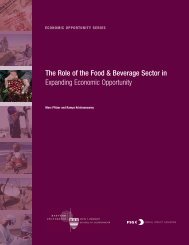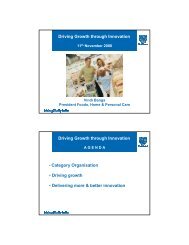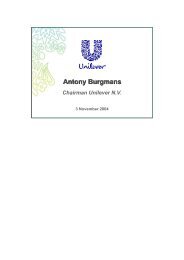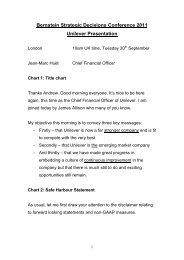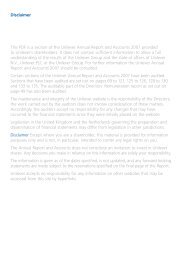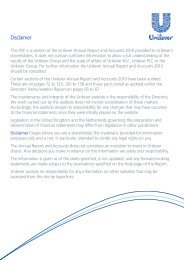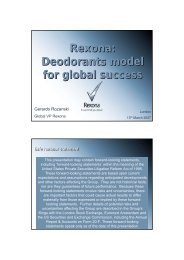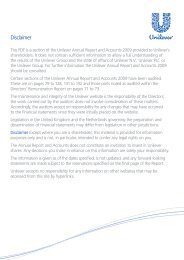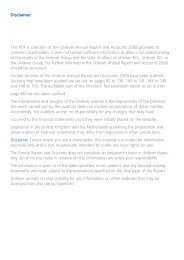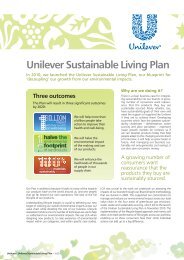Paper & board policy FAQx - Unilever
Paper & board policy FAQx - Unilever
Paper & board policy FAQx - Unilever
You also want an ePaper? Increase the reach of your titles
YUMPU automatically turns print PDFs into web optimized ePapers that Google loves.
UNILEVER SUSTAINABLE PAPER & BOARD PACKAGING SOURCING POLICY<br />
<strong>Unilever</strong>’s Sustainability Ambitions<br />
FREQUENTLY ASKED QUESTIONS<br />
• What is <strong>Unilever</strong>’s “sustainability strategy”? What about other renewable materials that<br />
<strong>Unilever</strong> source, are they all coming from sustainable sources to date?<br />
Our long-term aim is to buy all our agricultural raw materials from sustainable sources. In 1998, we<br />
developed Good Agricultural Practice guidelines for five of our key crops – palm oil, tea, tomatoes,<br />
peas and spinach. Our guidelines track progress against 11 sustainable agriculture indicators (water,<br />
energy, pesticide use, etc.)<br />
We focus our efforts on crops where we purchase significant volumes; where we have the greatest<br />
impact, and therefore the opportunity to make a difference.<br />
<strong>Unilever</strong> has a number of sustainability programmes in key crops such as tea, dairy, fruit and<br />
vegetables (see http://www.unilever.com/sustainability/environment/agriculture/default.aspx ).<br />
Our Sustainable Agriculture programme has been in place for over 10 years, and in 2009 <strong>Unilever</strong><br />
was named sustainability leader in the Food & Beverage sector of the Dow Jones Sustainability Index<br />
for the eleventh consecutive year.<br />
• Do you have sustainable sourcing commitments for other renewable materials, as well?<br />
Yes, <strong>Unilever</strong> has made global commitments on the following renewable materials.<br />
Palm Oil<br />
We have a public commitment to sourcing all our palm oil from certified sustainable sources by 2015,<br />
and we are taking strides toward achieving this goal. You can check the progress we are making on<br />
sustainable palm oil on our website:<br />
http://www.unilever.com/sustainability/environment/agriculture/sustainablepalmoil/default.aspx<br />
Tea<br />
Lipton has committed to source the tea for all its tea bags from Rainforest Alliance certified farms by<br />
2015. Already, 80% of Lipton Yellow Label and PG Tips sold in Western Europe comes from<br />
Rainforest Alliance certified farms.<br />
More than 30 tea estates have already achieved Rainforest Alliance certification, including <strong>Unilever</strong>'s<br />
own estates in Kenya and Tanzania.<br />
1
Soy<br />
The Policy<br />
<strong>Unilever</strong> is a member of the Roundtable on Responsible Soy, which seeks to implement agreed<br />
principles and criteria for responsible production.<br />
• What does “virgin” fibre mean?<br />
“Virgin Fibre” is fibre extracted from a plant of some sort, the most common being wood fibre from<br />
trees. In some cases trees are planted in forest areas with the purpose to get fibres for paper and<br />
<strong>board</strong> production, and in other cases wood is coming from timber industries and forest thinning.<br />
Typically fibre used for paper making is from timber that cannot be used for other purposes e.g.<br />
immature trees removed to let other trees mature (thinnings) and sawmill waste. Once this virgin fibre<br />
has been made into paper it can be recycled several times (typically 5 – 7).<br />
• Why are you not promoting to use material from Forest Stewardship Council (FSC) certified<br />
forests only?<br />
There are a number of reasons that prevent us from accepting only FSC certification. Firstly, there is<br />
not sufficient amount of certified material on the market. Secondly, FSC certification scheme at present<br />
is challenging to achieve for small forest owners.<br />
• The Policy accepts as certified both, FSC and national schemes endorsed by the Programme<br />
for the Endorsement of Forest Certification (PEFC). Does <strong>Unilever</strong> consider both certification<br />
schemes as equal? How are you going to ensure that PEFC and PEFC endorsed schemes<br />
certified products meet your minimum bar of “non-controversial sources”?<br />
As mentioned in the Policy, <strong>Unilever</strong> will give preference to sourcing FSC certified virgin paper or<br />
<strong>board</strong> wherever available and viable to do so, and recognizes FSC certification scheme as the most<br />
comprehensive Forest Management Certification Scheme globally. However, current supplies of FSC<br />
paper and <strong>board</strong> are not sufficient to satisfy all our demands in the volumes and qualities we require.<br />
In these cases where FSC is not available, we will rely on other certifications schemes under the<br />
condition that our “Non-controversial Sources” requirements are met, as included in our<br />
Implementation Guidelines. The requirements to achieve this will vary according to the level of “risk”<br />
associated to the timber harvesting country of origin. Rainforest Alliance is assisting us in developing<br />
tools and criteria to address all these aspects on a case by case basis.<br />
• Why don’t you accept other existing schemes, as well?<br />
After studying all the possibilities and consulting the available information and stakeholder views of<br />
other systems, we have concluded that currently there are no other existing forest certification<br />
schemes that could address our concerns. We will review regularly our <strong>policy</strong> and our implementation<br />
guidelines so in case new forest certification systems gain credibility and we find that could fit in our<br />
Policy’s requirements we will accept it.<br />
2
• What is <strong>Unilever</strong>’s definition of “recycled” material?<br />
Fundamentally “recycling” means giving material a second life rather than simply disposing of it. The<br />
recycled material used for our packaging comes from two main sources. “Post consumer waste” is<br />
packaging which has been used i.e. it has served its purpose. This represents around 85% of material<br />
used in our recycled packaging. The other (minor) source of recycled material is “post industrial”. This<br />
is material which for one reason or other was not used directly for the packaging. The most common<br />
form of post industrial waste is “clippings”, which is waste that is generated when packaging is cut to<br />
shape. As both post consumer and post industrial waste would be disposed of by sending it to landfill if<br />
not recycled, we do not differentiate between them.<br />
• How do you choose which fibres you use for an application, virgin or recycled?<br />
We start by looking at the application and what the packaging is required to do. Where safety<br />
regulations demand a virgin material then the choice is very simple. Where there is a choice it will be<br />
the best material for the application and the material that is most readily available, as not all materials<br />
are available everywhere. If we have a choice and recycled material is available delivering the<br />
performance required then we will give preference to recycled material.<br />
• How are you monitoring progress against your ambitious milestones?<br />
We require our suppliers to do a self-assessment and report on progress via internet enabled tool. The<br />
assessment data will be accessible to Rainforest Alliance for verification. We will also audit our<br />
suppliers’ self assessment on a regular basis using 3 rd party auditors.<br />
• Is there sufficient certified material available to achieve your 2020 milestone?<br />
Based on information from FSC and PEFC (full statistics can be found on<br />
http://www.fsc.org/publications.html and www.pefc.org/index.php/about-pefc/who-we-are/facts-afigures)<br />
the certified forest area is continuously growing globally.<br />
Our ambition will be to prompt our suppliers and their supply chain back to the forest towards a<br />
credible and acceptable certification that will have beneficial impacts on the ground.<br />
Thus, with the statistics on our side and the strong efforts we will make in order to move all our supply<br />
chain towards certified or recycled sources, we believe our goal will be achieved.<br />
Implementation guidelines<br />
• What sources have been used to define the Country Exception List?<br />
To comply with our Country Exception List we have consulted the publicly available information on the<br />
issues that affect our Policy (illegal logging; violation of traditional and civil rights; forests where high<br />
conservation values are threatened or forests being converted to plantations or non-forest use)<br />
The sources used have been:<br />
3
o NEPCon Global Risk Registry: http://globalforestrisk.nepcon.net/<br />
o WWF GFTN: http://gftn.panda.org/<br />
o Greenpeace: http://www.greenpeace.org.uk/tags/illegal-timber<br />
o EIA/Lacey Act: http://www.eia-global.org/forests_for_the_world/lacey.html<br />
o ILLEGAL-LOGGING: http://www.illegal-logging.info/<br />
• Non-controversial sources: What is a „Supplier’s own Risk Assessment of the country or<br />
district of origin (forest)”? A document? Could you please provide an example?<br />
During our annual audits, we will expect from the selected suppliers to have a full report in place for<br />
the district of origin of the fibre (country, region or forest management unit), proving that the source is<br />
“low risk” for each of the controversial categories (civil and traditional rights violations, threatened high<br />
conservation values or forest conversion), by confirming the following:<br />
o There is no UN Security Council ban on timber exports from the country<br />
concerned (www.globalwitness.org and www.un.org ).<br />
o The country or district is not designated a source of conflict timber (e.g.<br />
USAID Type 1 conflict timber); (www.usaid.gov ).<br />
o ILO (International Labour Organization) country office confirms that there is<br />
no evidence of child labour or violation of ILO Fundamental Principles and<br />
Rights at work taking place in forest areas in the district concerned and,<br />
when applicable, that there is no evidence of violation of the ILO<br />
Convention 169 on Indigenous and Tribal Peoples taking place in the forest<br />
areas in the district concerned (www.ilo.org ; local NGOs).<br />
o District of origin of source material is not included in the WWF Global 200<br />
(http://www.worldwildlife.org/science/ecoregions/item1847.html ) and is not<br />
considered a “Biodiversity Hotspot” (http://www.biodiversityhotspots.org )<br />
o A strong system of protection (effective protected areas and legislation) is<br />
in place that ensures survival of the HCVs in the ecoregion. (I.e. Country<br />
has signed to the Convention on Biological Diversity<br />
https://www.cbd.int/information/parties.shtml ; Reliable Local and Global<br />
Environmental NGOs, etc.)<br />
o There is no net loss AND no significant rate of loss (> 0.5% per year) of<br />
natural forests and other naturally wooded ecosystems such as savannahs<br />
taking place in the eco-region in question.<br />
(http://www.fao.org/forestry/41256/en/ ; Google Earth, Local ENGO)<br />
Please note that compliance with legality shall be demonstrated in all cases and that this option<br />
(a supplier’s own risk assessment report) will not be enough for countries included in the<br />
Country Exception List, where third party certification will be required.<br />
• Non-controversial sources: What do you mean by „regarded as equivalent by 3rd party audit<br />
initiated by <strong>Unilever</strong>”? Who are the approved 3 rd parties? What standards will they follow?<br />
When FSC Controlled Wood certification is not available for some acceptable reason and the forest is<br />
not engaged in a stepwise approach towards FSC certification, we may accept other third party<br />
verifications, which will be studied on a case by case basis. In these cases we will ask an independent<br />
auditor entitled for forest management certification (FSC or PEFC approved certification body) to audit<br />
compliance with the following categories:<br />
o Wood is not harvested in violation of traditional and civil rights;<br />
4
o Wood is not harvested in forests where high conservation values are<br />
threatened;<br />
o Wood is not harvested in forests being converted to plantations or nonforest<br />
use<br />
The standards that will be used as a reference in those cases are those suggested by the FSC<br />
Controlled Wood standard (FSC-STD-40-005 v.2) Annex 2 for the categories mentioned above.<br />
• Do you accept other Legality Certifications?<br />
Labeling<br />
Currently we will only accept as reliable legality verification schemes those mentioned in our<br />
Implementation Guidelines document. We have selected these after studying all the different options in<br />
the market with the help of Rainforest Alliance. A crucial document consulted in order to determine<br />
which legality verification systems could be reliable enough has been Greenpeace’s Legality<br />
Verification System’s Assessment<br />
(http://www.greenpeace.org/raw/content/international/press/reports/lvs-assessment.pdf ), from January<br />
2008. As with the rest of the Implementation Guidelines, we will be open to accept (or no longer<br />
accept) legality verification systems based on their performance.<br />
• Are you going make use of FSC and PEFC on pack logos?<br />
Yes, where possible, we plan to use FSC and PEFC logos on product packaging in line with the<br />
implementation guidelines and in full compliance with the <strong>policy</strong> requirements. We believe this<br />
approach increases transparency for our consumers and customers, and will help to raise awareness<br />
on the importance of certified material for consumers while increasing logo recognition.<br />
5


